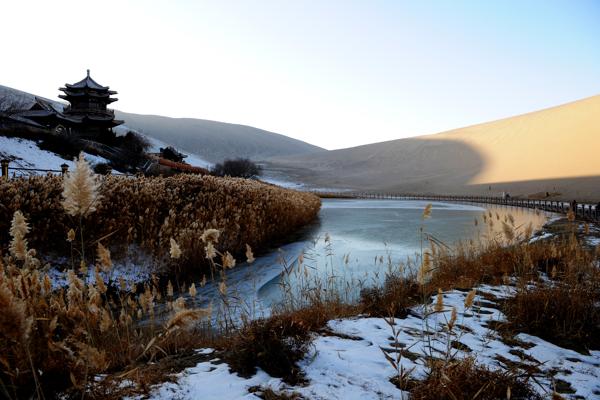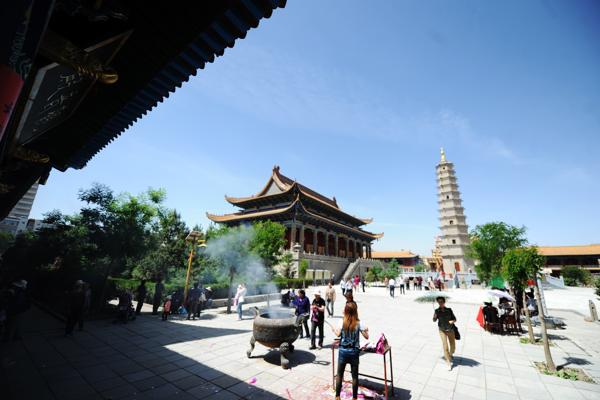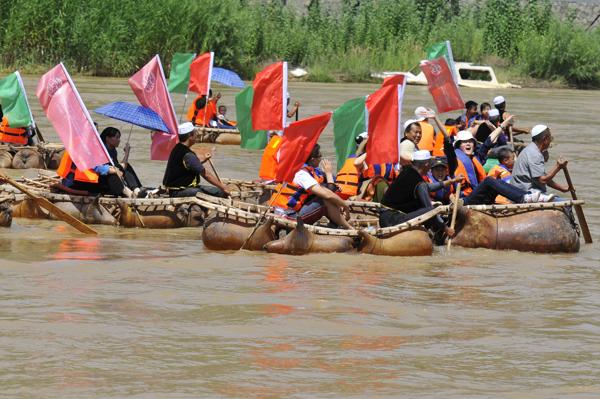
The Dunhuang Yueya Spring is one of the most famous tourist spots in Gansu province.[Photo by Xue Chaohua/China Daily]
Province prepares for crucial role in economic initiative, Xue Chaohua and Liu Xiangrui report.
Gansu province in Northwest China is actively integrating itself into the national strategy of the “One Belt, One Road” Initiative proposed by Chinese President Xi Jinping.
The initiative, referring to the Silk Road Economic Belt and the 21st Century Maritime Silk Road, were put forward by Xi during his visits to Kazakhstan and Indonesia in 2013.
The Silk Road Economic Belt is to be established along the ancient Silk Road trade route, stretching northwest from China’s coastal area through Central Asia and Europe, while the 21st Century Maritime Silk Road will run from southern China to Southeast Asia and even Africa.
Gansu province has carried out a series of practical research projects and put forward detailed plans for construction of the Gansu section of the Silk Road Economic Belt according to its historical resources, natural conditions and development foundation.
In the past, Gansu was a key transfer point and trading area along the ancient Silk Road.
With its rich history, diverse culture and many junction cities, Gansu has unique advantages and huge potential to play a crucial role in boosting the development of the Silk Road Economic Belt, which runs more than 1,600 kilometers westward through the province.
In 2014, the Party committee and government of Gansu province carried out a blueprint for constructing the Gansu section of the Silk Road Economic Belt.

A renowned Buddhist site, Kumarajiva temple in Wuwei, Gansu province, has a history of more than 1600 years.[Photo by Xue Chaohua/China Daily]
Currently, the province is making great efforts to build three major platforms under the concept of the economic belt-the Lanzhou New District, making Dunhuang into an internationally famous city of culture and tourism, and the China Silk Road Expo.
The local government is prioritizing related projects including road construction, trade and technology exchanges, industrial connections and cooperation, new economic growth poles, cultural exchanges and the establishment of strategic platforms.
Gansu will further enhance the support capacity of important junction cities within the area to build the province into a “golden passage” along the Silk Road Economic Belt, an important platform for opening to the West, a regional trade and logistics hub, a demonstrative base for industrial cooperation, and a bridge for cultural exchanges.
The central government has completed a comprehensive development strategy and blueprint for the Belt and Road Initiative by the end of 2014, which details Gansu’s strategic role, Lian Ji, head of Gansu’s publicity department, said recently.
Lian said the plan includes the positions and roles of Gansu’s junction cities along the economic belt. It also clarifies Gansu’s advantages.
The document exemplifies Gansu’s role in the strategic passage that connects West Asia, Central Asia and South Asia and its special role in Northwestern China and transportation in the region.
It specifies Gansu’s advantages in industries including manufacturing, new energy, modern agriculture, as well as historical and cultural resources. The plan also defines Gansu’s role as an ecological protection screen in Northwestern China and the entire country.
“These are important orientations for Gansu in the nation’s bigger blueprints,” Lian said.
The blueprint released by the Gansu government to implement the central government’s strategy clarifies Gansu’s goals, major tasks, and the key industries related to the economic belt, such as infrastructure, industrial technologies, and foreign trade.
“The plan is being implemented on different levels in Gansu now,” Lian said.
The 2015 report on the work of the Gansu provincial government noted that the province should combine the construction of the economic belt with regional development and opening-up, and enhance the construction of the New Eurasian Continental Bridge.

The “Tianma” international cargo train from Wuwei to in Almaty, Kazakhstan, is a highlight along the Silk Road Economic Belt.[Photo by Xue Chaohua/China Daily]
From the perspective of Gansu’s geological location, the primary task of regional cooperation is to ensure the smooth and efficient passage of goods and people, Lian said.
“Gansu’s Hexi Corridor is an unavoidable economic passage for projects relating electricity, oil and land traffic. We must work hard to ensure that the transport of international freight and economic exchanges are smooth.”
Lian added that ensuring a good ecological environment along the Hexi Corridor is another important aspect of the economic belt strategy.
He said culture is an important aspect of cooperation. Gansu is carrying out in-depth collaboration with Wasu Group from Zhejiang province and will partner with neighboring Shaanxi and the Xinjiang Uygur autonomous region to realize regionalized cooperation in the information industry.
Gansu has a culture that is vastly different from other parts of China. That unique culture, which is the result of exchanges between oriental and Western cultures and the cultural integration of Han people and other ethnic groups, has special advantages for international communication.
The Belt and Road Initiative has asked related regions to realize the “connection of people’s minds” and carry out multi-level political, economical and cultural exchanges with countries along the belt on the basis of cultural connection.
“To realize joint development, inclusion, mutual understanding and win-win cooperation, we need a process of communication and mutual approval,” Lian said.
“Cultural approval can help us find resonance and communicate easily. With cultural exchanges, it will be easier for Gansu to carry out cooperation in other aspects, such as infrastructure and trade, with other countries along the belt.”
The local government recently formed an international production team and produced a documentary about the historical Hexi Corridor.
“We hope that can be a cultural envoy and a name card of China,” Lian said.

Visitors ride on sheepskin rafts, made up of a dozen of inflated sheepskins, in Gansu province.[Photo by Xue Chaohua/China Daily]
A blueprint explaining Gansu’s targets relating to the economic belt, issued by the provincial government in May 2014, said the province would strengthen partnership and communication with governments and businesses in Central and West Asia, as well as East and Central Europe.
The blueprint also encouraged nongovernmental exchanges, including enhancing Gansu’s sister-city relationships with states and provinces in Kazakhstan, Kyrgyzstan, Iran and other nations.
It requires junction cities along the belt’s Gansu section to strengthen their connections with neighboring provinces and nearby nations along the belt.
In 2014, the Foreign Ministry of China and the Gansu provincial government jointly held the Asia Cooperation Dialogue Forum on Silk Road Cooperation. As the first international forum on the construction of the “One Belt, One Road” held in China, it established an important platform for Gansu to further open up to the West and boost the construction of the economic belt’s Gansu section. The “One Belt, One Road” strategy has brought new development opportunities for Gansu. “So far we have signed cooperation framework agreements on resource and energy with regions in Central and West Asia,” said Zheng Yajun, Party chief of Jiayuguan city in Gansu.
“We will need more resources and energy from those regions in the future, and developing new energy will also be a big part of our work.”
Since 2013, Gansu has quickened its pace of opening up westward. In 2013, it had an import-export volume of $2.7 billion with 27 countries along the economic belt, a rise of 23.6 percent year-on-year.
In the first four months of 2014, it realized trade volume of $2.3 billion with Asian countries. The figure shows further growth in its share of trade with Asian countries.
Meanwhile, 11 countries from Central and West Asia and Central and Eastern Europe have established 23 foreign-funded companies in Gansu.
According to Lian, as an important commercial port along the ancient Silk Road, Gansu province has constantly enhanced the economic and technological cooperation between itself and countries in Central and West Asia.
Gansu province will further strengthen exchanges and cooperation with countries along the economic belt in key areas including agricultural products, new material based on nonferrous metals, traditional Chinese medicine, petrochemical equipment manufacturing, and integrated circuit packaging. It will accelerate the construction of Gansu province as an export base.
It will also speed up the construction of Lanzhou as a regional gateway of international communications, and support the development of e-commerce enterprises, promote cross-border e-commerce and turn important node cities in Gansu into modern logistics bases servicing Central and West Asia as well as Northwest and Southwest China.
